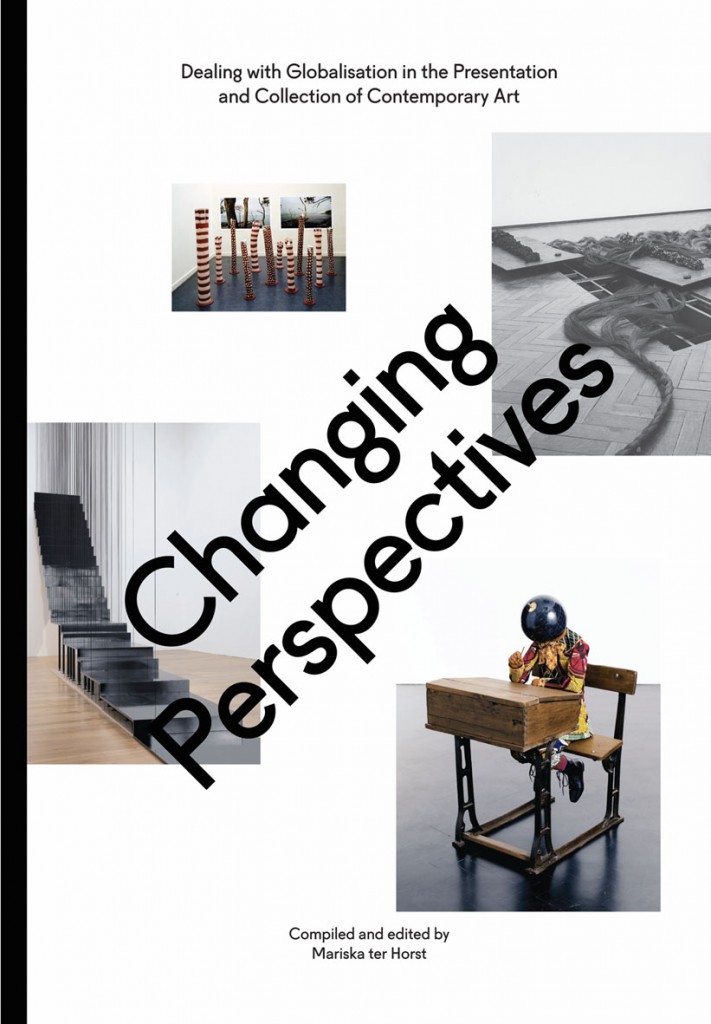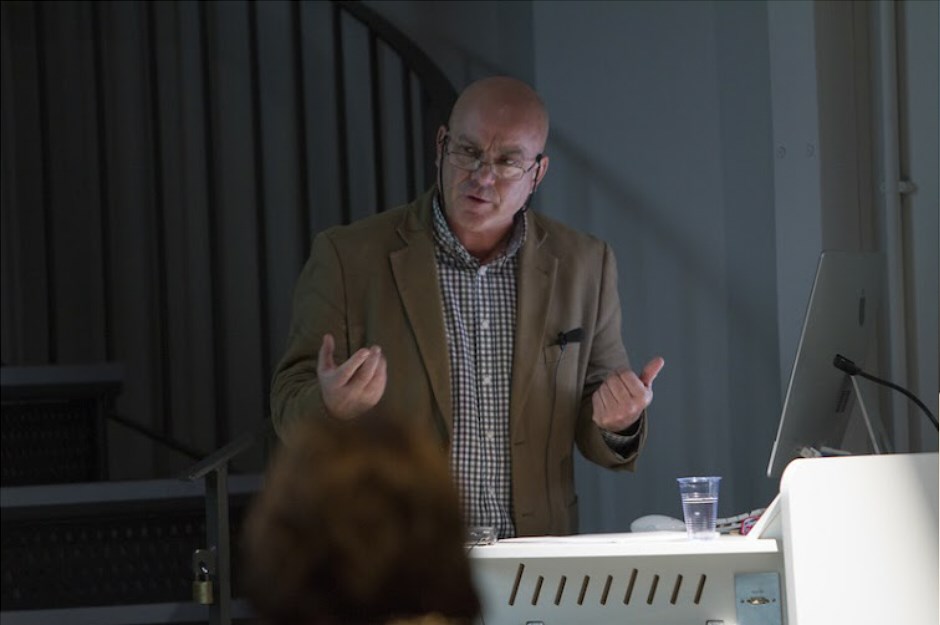 Publicatie: Changing Perspectives (KIT Publishers)
Publicatie: Changing Perspectives (KIT Publishers) Article: A response to the publication Changing Perspectives
A response to the publication Changing Perspectives: Critical Views on Collecting and Presenting Contemporary Art (KIT Publishers, 2012) by Professor Jonathan Harris.
I read the book with real interest and enthusiasm. It is a valuable and entertaining contribution to the critical discourse on the relations between art, culture and globalization processes. However…
Basic questions remain unanswered satisfactorily and concern themes & problems that need more consideration. There is just time to mention a few questions and problems here:
Firstly, what actually is ‘globalization’?
Now, I don’t see much analytic clarity or clear agreement on this across the essays in the book, despite confident use of the term as if its meanings were presupposed or self-evident. I think what this actually reflects is the reality that globalization isn’t most usefully seen as a singular concept but rather as a field, or problematic, of ideas, activities, experiences and processes. I encountered the same issue with my book, Globalization and Contemporary Art (Wiley-Blackwell 2011), where I commissioned (originally) 35 essays from authors in as many locations around the world as I could find outside of the US, the UK and Western Europe. But that book, aimed primarily at scholars and students, needed analytic consistency and a theoretical narrative to order these quite disparate texts which nevertheless, in their own ways, articulated globalization’s ideas, activities, experiences and processes. So I divided the essays into seven thematic-conceptual fields, or facets, of globalization. We could talk about the pros and cons of these later, but my intention had been to create some core, but correctable, hypotheses linking theoretical claims to the new empirical materials supplied by my 35 authors.
The timing of Changing Perspectives is significant here. Debate about postcolonialism, collecting and the role of museums has been on-going for more than twenty years. One of the key riddles of this book is: how does or should current thinking about globalization inflect or transform longstanding discourse on postcolonial societies, cultures and peoples? (I will try to suggest elements of an answer to this towards the end of my remarks.)
Big second question:
What are the characteristics and limits of the ‘critical thinking discourse’ capable of by state-paid intellectuals working for museums and galleries in the Netherlands, and elsewhere? (compared, for instance, with the limits and characteristics of ‘critical thinking discourse’ possible in the university sector).
How have, and do, museums and galleries impose controls and influence the character and consequences of such critical thinking?
What impact do processes of museum professionalism, and professionalization, have on the potential for critical thinking? Incidentally, Tate, which is referred to often in these essays (usually in a positive way) is now an organization which gets less than 50% of its financial resources directly from the British government – so the ‘public’/‘private’ distinction is also now, or again, problematic.
This matter is laden with historical and political contradictions. Both museum and university professional intellectuals speak as if they represent an existing ‘public sphere’ of debate and socio-moral inquiry (and I agree that they should), but this is within an historical conjuncture in which western institutions have been under attack by an alliance of economic, social and political neoliberal forces that would strip them of such a role and the resources previously available to them. The current crisis of the Eurozone/EU is the site for a battle raging between the neoliberals hitherto in charge of Anglo-American style western capitalist speculative finance capitalism and the largely fellow-travelling Euro-state political-bureaucratic class which now understands the continent-wide disaster looming if the forces of neo-liberalisation aren’t reigned in sufficiently. This is being played out now in the ‘austerity versus growth’ debate (or pseudo-debate) since Sarkozy lost power.
Historically, France, and the Netherlands I assume, had been somewhere in between the US-UK extreme on the one side and German social democracy on the other – but all this was thrown into another phase of chaotic re-organisation recently by the Greek and now Spanish components to the Euro/EU meltdown scenario.
(The questions of how the Cold War and 1990s German unification fit into the longer history of this Euro-reorganisation will have to be addressed in the discussion – but I was glad to see the Cold War raised in a couple of the essays in Changing Perspectives. My new book, The Utopian Globalists: Artists of Worldwide Revolution, 1919-2009 (due end of 2012) attempts to trace the origins of globalization and artists’ involvement in it back into the twentieth century. The Cold War and Joseph Beuys’ work from the 1950s to the 1980s is the conceptual and historical centre to it.)
Now, all these issues do relate importantly to the debates about post-colonialism and multiculturalism referred to in the essays in Changing Perspectives – but these relations are confusingly asymmetrical and uneven in historical and nation-state terms.
Third question and problem
The terms ‘contemporary art’ and ‘contemporary artist’ are used by authors in Changing Perspectives in mostly theoretically naïve (by which I mean ostensibly neutral ways) that work to obscure their complex relationship to the also unclear meanings of the term ‘globalization’ – with the effect that one set of conceptual and related ideological ambiguities is compounding another, leading to more confusion. Books recently by authors including Terry Smith, Anna Guasch and James Elkins indicate the value-laden premises that dictate who can or can’t be regarded as really within the discourse of contemporary and the contemporaneous – with, that is, the time of globalization. The instance of ‘Australian aboriginal art’ is one raised several times in Changing Perspectives and we should return to it.
Now, it would become tedious merely to list the many other contested terms and dyads of terms (sometimes used as analytic concepts), that constitute the discourse on which Changing Perspectives is based. A few of them, however, are:
‘Core/periphery’;
‘national’/’international’;
‘progress’;
‘western’/’non-western’;
‘cultural diversity’;
‘cultural heritage’
More interesting than such a listing – and perhaps because also ambiguous in its significance – is the observation that, across the whole range of the essays, but focussing on the contributions by professionals working in Dutch museums and galleries, virtually none of the deployed concepts (and the values attached to them) seem to me now to have any intrinsic or inherentlyprogressive meanings, though this was precisely the claim or assumption of many of the authors using them. Take this longer list:
‘indigenous’
‘aboriginal’
‘contemporary’
‘traditional’
‘modern’
‘universality’
‘authenticity’
‘canon formation’
‘Other’
‘inclusion’/’exclusion’
‘autonomous artwork’
‘ethnographic’
‘western’ / ‘non-western’
‘negritude’
‘difference’
Depending on the discursive-institutional museum context and its practical politics, all of these terms could refer to good or bad, desired or undesirable states or situations it seems to me. Some of these ‘goods’ and ‘bads’ were actually played out, in instructive historical and theoretical ways, across the essays in an unwitting form of ‘polylogue’ which is actually the book’s main strength.
Here are a few synoptic claims I have constructed from the essays. They range from the orthodox to the heterodox:
*some artists who are non-western don’t want to see their works shown in ethnographic museum displays but do want to see their Otherness recognised…
*traditional elements to art practices need to be preserved over and above hybrid contemporary western elements in globalized art…
*art works in western museum collections and displays articulating negritude actually constitute damaging Eurocentric assimilations and appropriations, not genuine recognitions of their place within the canon..
*assimilation is a form of true belongingness and the purpose of cultural diversity policies…
*sometimes one wants to be or remain peripheral…
*Inauthenticity is authentic
*No one knows what it is to be Dutch anymore
*the autonomous work of art is a myth
*the autonomous work of art is real
*Only international jet-setting African museum curators want to, or need to, or could, believe in ‘post-ethnicity’
To begin to answer the question I set myself earlier: how has globalization altered the debates about postcolonialism and museum policy? – the answer is that it has worked
*to scramble and confuse our senses of what culture and art is, or is for…
*to undermine politically accepted but philosophically and culturally essentialist categories…
*to sabotage western nation-state professional intellectuals’ stable senses of ‘us’ and ‘them’…
In conclusion, the essays in Changing Perspectives revealed to me as much about the self-image of museum professionals in the Netherlands as they did about the debates on postcolonialism and globalization or about the role of museums.
Perhaps we could also usefully consider:
*the matter of how professionalised museum curators and educators see their own institutional power and how this has changed since the 1980s…
*the mismatch between the self-styled liberalism and progressivism of Dutch museum professionals and the real politic of neoliberal states and funding conditions…
*the erosion of earlier clearer, if not clear, distinctions between public and private, and between state and non-state and the significance of this…
Finally, as a dissident art historian nevertheless trained in the modernist critical tradition, I was struck by the lack of open discussion in the book of the idea or significance of good and bad art – and how that lack might also be, in specific ways, both good and bad…
By Professor Jonathan Harris
Museologie / Global Art History /
Netwerk
